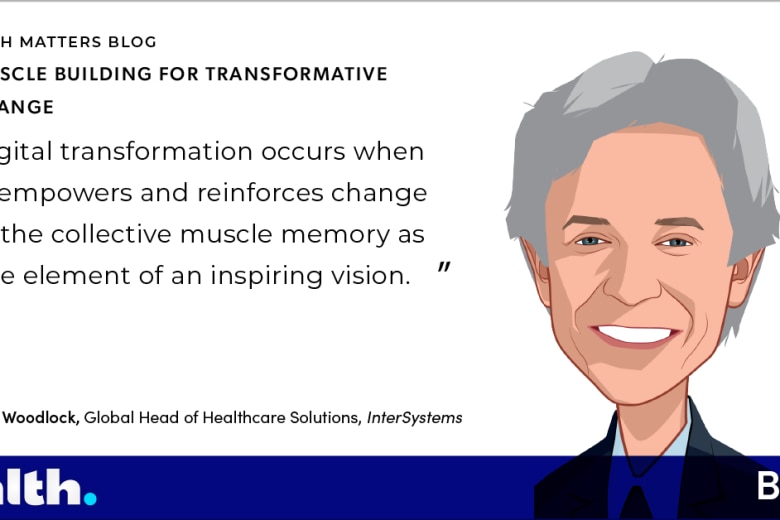Will Blockchain Ever Really Matter in Healthcare?

Blockchain (Distributed Ledger Technologies or DLT) is being touted as the next technology to revolutionize healthcare. It has been presented as the answer for everything from interoperability to insurance processing. But is it really?
I have spent years in product management organizations, where the ultimate goal was to get viable commercial solutions to market, I am skeptical of many early blockchain claims. If the attitude is “blockchain is the answer, what’s the question?” there is a high probability that many of the proposed use cases for blockchain will not solve the problems they claim to solve.
I wrote those words some 19 months ago, and in May of 2019, I find we are no closer to answering those questions than in November 2017.
A recent survey from Venrock touted “AI is slowly finding its place, while blockchain struggles as much in healthcare as in other segments,” “At the typical pace innovation matures in healthcare, blockchain may never matter…..” According to the survey, 75 percent are still struggling to find blockchain’s role in healthcare, 18 percent have found ways blockchain can be used to benefit patients. The last 7 percent are still asking, “What’s a blockchain?”
In addition, the news surrounding cryptocurrencies, the gold standard of blockchain use cases, has been very negative for quite some time. The problems that are now surfacing in the crytptocurrency markets are not those of an emerging technology, but rather the exposure of fundamental flaws in our understanding of the technology itself. As Nicholas Weaver, researcher at the International Computer Science Institute (ICSI) and University of California, Berkeley described in a recent talk; CRYPTOCURRENCY: BURN IT WITH FIRE, “For all of those who say ‘blockchain will solve X,'” the only thing it solves is you now know the person knows nothing about X.”
The renewed interest in “permissioned” or “private” chains that supposedly can be used in new ways to keep records is really just a rehash of old methods, according to Weaver, and that these chains have existed for decades in the form of hash chains and have already been used for just about anything that could benefit from it.
What’s worse, Weaver said, is that public blockchains are woefully wasteful and inefficient. The result is that bitcoin and other cryptocurrencies waste what Weaver said is an “obscene amount of resources.” A central authority that designated 10 trustworthy entities could generate the same blockchain with “10 Raspberry Pis using less power than an incandescent light bulb.”
Ultimately, Weaver said, the only things cryptocurrency is useful for paying for are ransoms and conducting other illicit transactions.
So let us revisit some of the key areas blockchain has been proposed as a solution and see what my 2019 take on the potential is, compared to 18 months ago and try to analyze objectively.
Any Use Case That Would Involve Actually Storing Patient Records
Blockchain at its core is really about a distributed ledger. It can work well for financial applications because most financial transactions involve relatively simple accounting principles, which have been around since the Renaissance. The whole concept of precision medicine, whereby a true patient record can be made up of all patient data from a wide variety of rich data sources make this a non-starter.
As an example, the Bitcoin blockchain, which started in 2008, is
156.41GB, containing all nine years of historical data (Credit:
Andrea’s Blog). When we look at typical data storage needs for common storage intensive healthcare data, we see an immediate problem.
- X-Ray = 30 MB
- Mammogram = 120 MB
- 3D MRI = 150 MB
- 3D CT Scan = 1 GB
- Digital Pathology images = 350 MB on average.
- 100 GB for 1 billion reads – typical human genome
- 1 GB for each genomic Variant file
We’re generating petabytes of healthcare data each year and its growing exponentially. Blockchain technology is distributed by design, storage space is limited, so small data or metadata is preferable.
Just like “cloud” means someone else’s computer and “AI” means a tweaked algorithm, “blockchain” in this context means a slow, expensive database.
The overhead, slow development, user incentive issues, and scaling challenges really make blockchain a non-starter for storing large chunks of data and certainly nothing as complex as a medical record.
Blockchain is just not a solution for storing healthcare data, which will limit how it can actually help in key areas like analytics.
Interoperability and a Replacement for Information Exchanges
Much of the hype of blockchain is that it has the potential create a distributed longitudinal view of a patient’s data, drawing from multiple sources over time, culled from hospital stays, outpatient visits, wearable device data and more. In this concept, it acts like a Health Information Exchange.
Blockchain’s interoperability, security potential, of course, distributed nature could enable the Holy Grail of a longitudinal health record by securing data as it’s exchanged among organizations in a format that is usable for various clinicians across the care continuum.
“Blockchain effectively takes out the middle man; conceptually you would not have these health information exchanges that have struggled to get to mainstream,” explains Vince Vickers, KPMG’s healthcare technology leader. “There have been a lot of good efforts in certain states, and some HIEs have done well, but in relative terms, [compared] to the financial services industry—where I can go to an ATM, no matter where I am in the world, and get my money—patient data obviously is very limited in that way.
This thinking misses the fundamental challenge of healthcare interoperability; exchanging healthcare data in a meaningful way is about true semantic interoperability which is a major challenge for something as complex as a longitudinal patient record comprised of clinical data, omics, claims, IoHT and social data. A multitude of varying formats and standards, as well as a large amount of information being stored as unstructured data make this orders of magnitude more complex than an ATM network.
The ISO 8583 transaction standard being used for financial transactions is child’s play compared to exchanging healthcare information. It should also be noted that the modern ATM network took 40 years and serious collaboration amongst the transaction stakeholders to get where we are today. There are still many interbank networks, which operate in the background that act as exchanges, just like HIEs. Then there is the whole issue of $3 per transaction, if healthcare operated on that business model, interoperability could be solved quickly, but that is a topic for another post.
Many HIEs are already federated data exchanges where information is not aggregated centrally, but rather still resides across the network with the HIE functioning as a registry of where the data is stored. Sound familiar, it should because that is what block is, a distributed registry. Therefore, could blockchain improve the operational aspect of information exchange registries? Possibly, but it will have to evolve dramatically to handle the real processing needs. There could certainly be a place for blockchain technology as part of the overall process of validating certain elements of interoperability, but it will not be major disruptor. Blockchain will not magically replace or improve on interoperability.
Another factor that works against this as a “killer” use case is that many of the distributed HIEs are moving to central aggregation to support population health and analytics. Distributed data is incredibly hard to analyze and using DLT is an expensive way to solve the problems for what are generally cash-strapped HIE initiatives.
Population Health Efforts
Another potential healthcare application touted for blockchain is population health. Instead of relying on health information exchanges or other ways to aggregate data, organizations can eliminate the middleman and access patient databases on a large, population scale via distributed ledgers. “Spending time and resources verifying members’ trustworthiness (e.g., HIE, all-payer claims database, local EMRs) no longer makes savvy business sense. Blockchain will leap frog population health by providing trust where none exists for continuous access to patient records by directly linking information to clinical and financial outcomes,” reports CIO.
As noted above, this one didn’t pass the reality test a year and a half ago and still does not. Analyzing data across a distributed network that may exist in documents, unstructured data and a variety of formats is a data scientist’s nightmare. It is the same problem plaguing many data lakes inside organizations. They are unwieldy collections of data that are nearly impossible to use for quality analytics. Adding the computational overhead of blockchain to already cumbersome and difficult analytics is no solution at all.
Given the critical need for precise analytics in medicine the idea that blockchain will create a magical future seems very far-fetched.
Revenue Cycle, Claims Adjudication and Prior Authorization
Many have proposed that blockchain holds the promise to improve claims adjudication and billing management, which would minimize improper billing and reimbursements across the payer industry. The idea is the blockchain will let all participants in the healthcare claims and reimbursement system view patient claim processes in real time to improve reimbursement speed and transparency during the claims process and that this improved transparency will further automate prior authorization, referrals, and dynamic, autonomous claims adjudication. I am again quite skeptical as to how blockchain will improve claims adjudication, but big players are at least exploring blockchain options.
The challenge as I see it is that claims and prior authorization process are not simple “contracts”. Processing a claim involves hundreds of thousands of logic rule combinations, it is not the transaction, but the adjudication that is complicated. Prior Authorization involves matching complex healthcare documentation to pre-set approval rules. Complex transaction are not areas where blockchain is particularly well suited, even as DLT promoters talk about “smart contracts”. There seem to be serious limitations to this concept. The claims processing and adjudication business is already highly automated and efficient. Claims are essentially already real-time. In fact, claims are pre-edited at the provider office to ensure a high First Pass Resolution Rate (FPRR). FPRR is already above 90% in most cases. And the cost of financial clearinghouse transactions is incredibly low, so why would you add in the computation cost of blockchain to an already efficient central authority model? Truth is you probably would not, and most of the efforts to tout blockchain by organizations like Change Healthcare are more likely related to their impending IPO and putting a hot technology spin on what is a boring, but profitable central authority based business model.
So will organizations be willing to invest in rewriting their systems to support blockchain, maybe, but the investment will be substantial and challenging in an area of healthcare where pennies already count.
Supply Chain Improvements and Provenance
Tracking the authenticity or accuracy of medical supplies is difficult. Particularly as the supply chain expands globally. It has long been thought that blockchain could play a role in improving the integrity of pharmaceutical products, better controlling the expanding problem of counterfeits. It is hoped that some of the early efforts that IBM/Hyperledger are involved in that focus on food safety in China will likely spill over to more focused health system applications and pharmaceutical supply chains.
Color me skeptical on this one as a slam-dunk for blockchain.
Blockchain use cases are often described as best when they are trying to circumvent a central authority.
Blockchain systems do not miraculously change human behavior, nor do they automatically create data integrity, they merely enable you to audit whether an entry has been tampered with. A person who ships counterfeit drugs can still enter onto a blockchain system that the drugs are authentic and fraudsters can still ship legitimate drugs to illegitimate places.
Supply chain reporting is already problematic, even though for much of healthcare you have a small handful of players, McKesson, Cardinal, Amerisource that have detailed supply chain data, there are still major problems. Mostly due to misaligned incentives and bad actors.
In just two years, drug giant McKesson Corp. shipped nearly 5 million prescription painkillers to a single pharmacy in a Southern West Virginia town with 400 residents.
Cardinal Health, supplied Family Discount Pharmacy in Mount Gay with 6.5 million doses of hydrocodone (sold under brand names like Lortab and Vicodin) and oxycodone (sold as OxyContin) between 2008 and 2012. That’s 3,561 painkillers a day to a single pharmacy in rural Logan County.
Would blockchain solve the problem if the transaction was fraudulent from the get go?
Where I see promise
My skepticism of blockchain’s potential in healthcare is just as strong as it was previously. It still very much seems a technology in search of a purpose. However, I do see potential for blockchain to support new opportunities in four areas that have at least the basic hallmarks of uses cases for DLT.
Patient Data Management
Patient Identity management still continues to vex the healthcare system. Even in countries that have created national patient identifiers, software to match patients is often still needed to match records. It is also a challenge that has been a failure when looked at through the lens of a centralized authority would be a cheaper and easier path. Consumer Credit Reporting agencies have done a terrible job, both in establishing unique people identifiers and in being stewards of valuable patient identity data. The ability to create bottom-up unique identifiers and hash disparate clinical records into a common identity services, could be a real benefit to healthcare and multiple industries. It is also a use of blockchain that actually has strong enough incentives for the patient to actually do the work of maintaining the record!
Provider credentialing
Like patient identity, managing healthcare provider directories at each health plan and government agencies is a thankless and resource intense activity. Today, each of the more than 1000 insurance companies in the US tries to recreate a single, accurate directory of its providers, mostly by placing the burden of updating data on the clinician. Or at least requiring the clinicians to validate the data. Putting provider demographic information on a permissioned blockchain seems like a good thing to do. It is obvious the old way is not working, as any insurance organization will tell you, their provider data is not clean, and if there is an option to have a single curated record on a permissioned blockchain, clinicians would also be motivated, like patients with their identity, to maintain and validate the data.
In fact, United Healthcare, Optum, Humana, Quest Diagnostics, and MultiPlan launched the Synaptic Health Alliance to do just that, leveraging DLT to improve the accuracy of provider directories. Recently, Aetna and Ascension Health have joined the consortium.
Consent management
Unlocking the ability to mine data held in ever-growing repositories of clinical data is critical to the concept of precision medicine. To ensure appropriate data access, means solving the challenge of consent management. Today, patient consent is stored in a lot of places; electronic health records systems, hospital medical records departments, EDC systems and in stacks of paper on fax machines. The process is riddled with errors and challenges due to changes in protocols, failures to re-consent, use of non-approved forms, changes in child assent, and other complications. DLT may enable the storage of patient consent for data exchange and privacy preferences and treatments on the blockchain, so they can be accessed by all stakeholders, enabling easier sharing of information.
The higher degree of control offered to patients in the consent process for while also supporting tighter networks of patients and researchers, can also unlock some interesting potential for appropriate monetization of data.
Monetization of Data
Healthcare data is valuable. Big Pharma spends billions of dollars each year on research and much of that spend is wasted. Driving more intelligent and targeted research requires data, but the cumbersome consent processes currently in place are stifling potential innovation. The ability for health systems or patients to resell data without full disclosure and consent has proven problematic. Blockchain technologies, with good consent management, could enable a marketplace for data enabled people who want to contribute data to be paid each time their data were used? This creates very interesting potential for public benefit in clinical trials, clinical research, public health or population health analysis. The money is already being spent today on inefficient methods, think subway advertisements for clinical trials, so why not use blockchain to build a better mousetrap?
Since my last review of the state of blockchain in healthcare it is true that not much has changed. However, the industry has at least begun to find a small set of targeted use cases where DLT could make a difference.
Blockchain may not wind up being a technology that changes everything and touches all aspects of healthcare, but if it can incrementally solve key data curation issues like patient identity, provider credentialing and consent management, it will enable major advances in healthcare. So while blockchain may only improve the processes for patients and providers to more directly control their data, it would have made a significant contribution to the digital future of healthcare.
And we’ll see when I look back in another 18 months if my prognostications have aged well or not, but I will certainly continue to watch.
PS. If you’re interested in following the progress of various blockchain projects, there is a useful Github site moderated by Andrea Coravos that is worth checking out including this graphic of healthcare blockchain projects.

*Originally published by HealthcareITtoday here on May 24, 2o19.




































